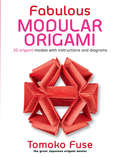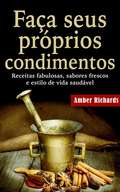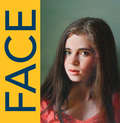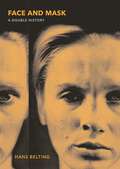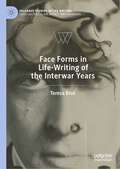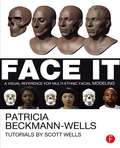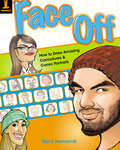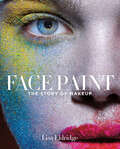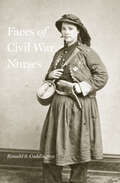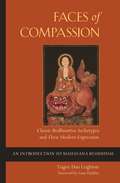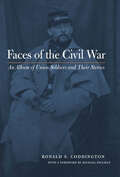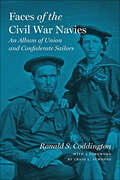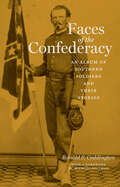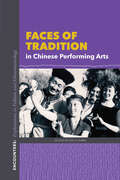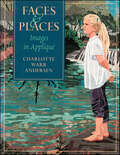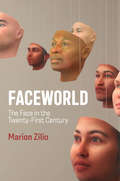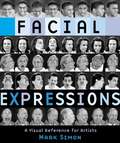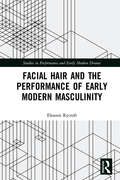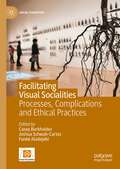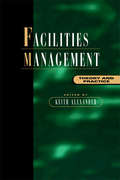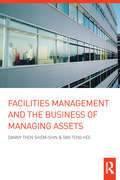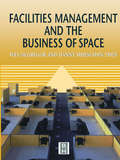- Table View
- List View
Fabulous Modular Origami: 20 Origami Models with Instructions and Diagrams
by Tomoko FuseFrom the queen of modular origami comes this collection of extraordinary models for folders of all skill levels. Tomoko Fuse's full-color guide shows how to join separately folded modules to create masterpieces of the paperfolding art. The 20 projects range from the simplest, consisting only of two parts, to the most demanding, some of which feature 30 modules. Illustrated directions accompany each of the figures, which are graded according to difficulty. The selections begin with easier models — including a square coaster, ninja star, and crown — and advance to slightly more complex projects — a flower with a stand, pleated and curled decorations, a crane, cubes, and a morning glory. The most sophisticated challenges include a pumpkin, a mosaic podium, a three-part triangular model, and the tetrahedron-and-octahedron combination called The Barber. Paperfolders' personal choices and combinations of colors will add individual flair to this stunning variety of models.
Faça o Dinheiro Colecionando Itens Fáceis de Achar do Dia a Dia
by Bernard Levine Melissa Maia MoscosoNesse compêndio único e divertido, você vai descobrir um monte de coisas maravilhosas para colhecionar que irão recompensá-lo com uma vida de grande prazer colecionando CD´s de rock´n´roll, Brinquedos de Fast-Food, ursos de pelúcia, selos, moedas, antigas máquinas de escrever, câmeras, jogos de computador , Comics, canetas tinteiro, conchas do mar, figurinhas de basebol, Mapas, Autógrafos, cartões, latas de cerveja, partituras de música, colheres de chá e muito mais!
Faça seus próprios condimentos - Receitas fabulosas, sabores frescos e estilo de vida saudável
by Amber Richards Antonio Jorge SantosNão use condimentos de baixa qualidade, super processados e caros nas suas refeições! Obras primas da culinária para as mesas de jantar da sua família. De refeições à lanches, Você encontrará centenas de receitas para sabores frescos e estilo de vida saudável neste lindo ebook! Os resultados são óbvios: Alto nível de sabor para as suas papilas gustativas e aguçar a sua criatividade, sem química ou efeitos colaterais dos condimentos industrializados. Você trabalha muito na cozinha, porque usar condimentos que sabotam a sua paixão de preparar alimento com amor?
Face
by Valentin PopovFace chronicles the development of artist Valentin Popov’s traveling exhibition of the same name-a suite of 100 uniformly-sized portraits surveying a social subset of selected friends, acquaintances, and celebrities. Popov explores the mystique of the face not only as the primary organ of human individuation and the immediate modulus of interpersonal recognition, but with respect to such intriguing intangibles as the eternal dialectic between objectivity and subjectivity and the face’s ambiguity as both mirror and mask.Popov has explored a wide variety of subject matter and media in his art, and all of his works feature the skilled technique and formal ability for which he has become known. His pieces speak to the lineage of art history, yet sometimes vacillate between homage and parody, often laced with a sense of humor, irony, or Pop.In his latest series, Popov revisits an idea once put forth by Andy Warhol who documented the faces of his friends and acquaintances through photographs and silk screen paintings, many of which were produced at a uniform scale of 40 x 40 inches. Warhol once spoke of mounting an exhibition of these portraits in which the walls would be filled from top to bottom with faces. Face re-examines the portraiture tradition and frames it in postmodern perspective.Featuring lush, full-color plates and insightful text by Peter Selz and other noted critics, curators, and commentators, this exquisite volume is sure to delight the eye and take pride of place among contemporaneous chronicles of cutting-edge portraiture.
Face and Mask: A Double History
by Hans BeltingA cultural history of the face in Western art, ranging from portraiture in painting and photography to film, theater, and mass mediaThis fascinating book presents the first cultural history and anthropology of the face across centuries, continents, and media. Ranging from funerary masks and masks in drama to the figural work of contemporary artists including Cindy Sherman and Nam June Paik, renowned art historian Hans Belting emphasizes that while the face plays a critical role in human communication, it defies attempts at visual representation.Belting divides his book into three parts: faces as masks of the self, portraiture as a constantly evolving mask in Western culture, and the fate of the face in the age of mass media. Referencing a vast array of sources, Belting's insights draw on art history, philosophy, theories of visual culture, and cognitive science. He demonstrates that Western efforts to portray the face have repeatedly failed, even with the developments of new media such as photography and film, which promise ever-greater degrees of verisimilitude. In spite of sitting at the heart of human expression, the face resists possession, and creative endeavors to capture it inevitably result in masks—hollow signifiers of the humanity they're meant to embody.From creations by Van Eyck and August Sander to works by Francis Bacon, Ingmar Bergman, and Chuck Close, Face and Mask takes a remarkable look at how, through the centuries, the physical visage has inspired and evaded artistic interpretation.
Face Forms in Life-Writing of the Interwar Years (Palgrave Studies in Life Writing)
by Teresa BruśThis book is an interdisciplinary study of the engagement with and representation of the face across literature, photography, and theatre. It looks at how the face is an active agent, closely connected with the history of the media and the social interactions reflected in media images. Focusing on the dynamic period of the interwar years, it explores a range of case studies in Poland, UK, and the US, and examines artists like Stanisław Ignacy Witkiewicz (Witkacy), Virginia Woolf, Debora Vogel, Sir Cecil Beaton, Theodore Władysław Benda, and Edward Gordon Craig. Teresa Bruś argues that these writers and photographers defended the face against threats from modern life – not least, the media. She focuses on transformations of the face in life writing across a range of media and draws attention to the artists’ autobiographical narratives.
Face It: A Visual Reference for Multi-ethnic Facial Modeling
by Patricia Beckmann WellsFace It presents practical hands-on techniques, 3D modeling and sculpting tools with Maya and ZBrush production pipelines, uniquely focused on the facial modeling of 7 ethnicity models, featuring over 100 different models ranging in age from newborn to elderly characters. Face It is a resource for academic and professionals alike. Explore the modeling possibilities beyond the digital reference galleries online. No more having to adapt medical anatomy texts to your own models! Explore the finite details of facial anatomy with focus on skull development, muscle structure, ears, eyes, nose and mouth paired with side by side comparisons of reference photos, anatomical construction and chapter focused 3D tutorials.
Face Off: How to Draw Amazing Caricatures & Comic Portraits
by Harry HamernikDiscover the fast, fun art of drawing comic portraits! Face Off shows you how to draw life like never before. Caricaturist Harold Hamernik shares the secrets to capturing the sillier side of friends, family, celebrities, strangers - any face that crosses your path. 40 step-by-step demonstrations show you how to sketch whimsical and expressive likenesses while developing your own quick, loose, improvisational style. You'll get expert instruction on: Drawing eyes, noses, mouths and other features. Creating portraits in front, three-quarter and profile views. Adding color to your caricatures, either by hand or via computer - instruction you won't find in any other book! Tips for making a likeness more masculine (skip the eyelashes), more feminine (lengthen the neck), younger, older, sexier, goofier . . . all while making a portrait your subject will love. How to draw hair as two simple lines, why drawing the parts of a face in the same order every time can cut minutes off your work, and tons of other handy tricks of the craft! Practice the simple techniques in this book, then start drawing! It's the most fun you can have with paper, pencils and markers!
Face Paint: The Story of Makeup
by Lisa EldridgeThe “exquisite and richly illustrated” New York Times bestseller from the renowned makeup artist, “a retrospective written for all women, everywhere” (Vogue France).Makeup, as we know it, has only been commercially available in the last 100 years, but applying decoration to the face and body may be one of the oldest global social practices. In Face Paint, Lisa Eldridge reveals the entire history of the art form, from Egyptian and Classical times up through the Victorian age and golden era of Hollywood, and also surveys the cutting-edge makeup science of today and tomorrow. Face Paint explores the practical and idiosyncratic reasons behind makeup’s use, the actual materials employed over generations, and the glamorous icons that people emulate, it is also a social history of women and the ways in which we can understand their lives through the prism and impact of makeup.“Makeup artist and Lancome global creative director Lisa Eldridge drops serious knowledge in Face Paint, her book on the history of beautifying.” —Marie Claire“Clear your coffee table and turn off YouTube—Lisa Eldridge’s book is a must read.” —Teen Vogue “The book is not only rich with history but also with a series of paintings, sketches and photographs in an intense array of colors, selected by the make-up artist herself in the most aesthetically pleasing universal statement to women you’ll ever see.” —Vogue France“Face Paint delves into the history of makeup, with glossy pictures to match . . . the book’s cover is striking.” —New York Post
Faces of Civil War Nurses
by Ronald S. CoddingtonA collection of rare archival images and biographical sketches of the dauntless women who served as nurses and caregivers during the Civil War.During the American Civil War, women on both sides of the conflict, radiating patriotic fervor equal to their male counterparts, contributed to the war effort in countless ways: forming charitable societies, becoming nurses, or even marching off to war as vivandières, unofficial attachés to the regiments.In Faces of Civil War Nurses, Ronald S. Coddington turns his attention to the experiences of 77 women of all ages and walks of life who provided care during the war as nurses, aid workers, and vivandières. Their personal narratives are as unique as fingerprints: each provides a distinct entry point into the larger social history of the brutal and bloody conflict. Coddington tells these determined women's stories through letters, diaries, pension files, and newspaper and government reports. Using identified tintypes and cartes de visite of women on both sides of the war, many of them never before published, Coddington uncovers the personal histories of each intrepid individual. Following their postwar stories, he also explains how the bonds they formed continued long after the cessation of hostilities. The fifth volume in Coddington's series on Civil War soldiers, this captivating microhistory will appeal to anyone with an interest in the Civil War, women's studies, social history, nursing, or photography. Praise for Ronald Coddington's Faces Series"An engaging look at a neglected part of the history of the American Civil War."—Booklist"Coddington has hit upon a unique and fascinating niche in the seemingly endless march of Civil War books."—C&RL News"A lavishly produced visual record of southern Civil War soldiers... will appeal to serious photography enthusiasts and collectors, as well as those readers captivated by the personal stories of Civil War soldiers."—Civil War Books and Authors"Coddington's prose is as unpretentious as the faces he shares, yet authoritative. It resurrects details that broaden our understanding of those sad times and sheds valuable light on the shape of modern culture."—Atlanta Constitution"Even at a distance of over a hundred years, the faces staring out of these pages create an undeniable emotional connection with the reader. This book is highly recommended."—H-CivWar, H-Net Reviews"A fascinating window into the war's impact on the individual soldier... well researched and engagingly written. Any teacher of the Civil War would do well to consult this volume and incorporate some of the captivating tales into lectures and readings."—Journal of Military History
Faces of Compassion: Classic Bodhisattva Archetypes and Their Modern Expression — An Introduction to Mahayana Buddhism
by Taigen Dan Leighton Joan Halifax RoshiFaces of Compassion introduces us to enlightened beings, the bodhisattvas of Buddhist lore. They're not otherworldly gods with superhuman qualities but shining examples of our own highest potential. Archetypes of wisdom and compassion, the bodhisattvas of Buddhism are powerful and compelling images of awakening. Scholar and Zen teacher Taigen Dan Leighton engagingly explores the imagery and lore of the seven most important of these archetypal figures, bringing them alive as psychological and spiritual wellsprings. Emphasizing the universality of spiritual ideas, Leighton finds aspects of bodhisattvas expressed in a variety of familiar modern personages - from Muhammad Ali to Mahatma Gandhi, from Bob Dylan to Henry Thoreau, and from Gertrude Stein to Mother Teresa. This edition contains a revised and expanded introduction that frames the book as a exciting and broad-scoped view of Mahayana Buddhism. It's updated throughout to make it of more use to scholars and a perfect companion to survey courses of world religions or a 200-level course on Buddhism.
Faces of the Civil War: An Album of Union Soldiers and Their Stories
by Ronald S. CoddingtonArchival images and biographical sketches of Union soldiers tell the stories of their lives during and after the Civil War.Before going off to fight in the Civil War, many soldiers on both sides of the conflict posed for a carte de visite, or visiting card, to give to their families, friends, or sweethearts. Invented in 1854 by a French photographer, the carte de visite was a small photographic print roughly the size of a modern trading card. The format arrived in America on the eve of the Civil War, which fueled intense demand for the convenient and affordable keepsakes. Considerable numbers of these portrait cards of Civil War soldiers survive today, but the experiences—and often the names—of the individuals portrayed have been lost to time. A passionate collector of Civil War–era photography, Ron Coddington became intrigued by these anonymous faces and began to research the history behind them in military records, pension files, and other public and personal documents.In Faces of the Civil War, Coddington presents 77 cartes de visite of Union soldiers from his collection and tells the stories of their lives during and after the war. The soldiers portrayed were wealthy and poor, educated and unschooled, native-born and immigrant, urban and rural. All were volunteers. Their personal stories reveal a tremendous diversity in their experience of war: many served with distinction, some were captured, some never saw combat while others saw little else. The lives of those who survived the war were even more disparate. While some made successful transitions back to civilian life, others suffered permanent physical and mental disabilities, which too often wrecked their families and careers. In compelling words and haunting pictures, Faces of the Civil War offers a unique perspective on the most dramatic and wrenching period in American history.
Faces of the Civil War Navies: An Album of Union and Confederate Sailors
by Ronald S. CoddingtonArchival images and biographical sketches of common sailors on both sides of the conflict reveal the human side of the Civil War.During the American Civil War, more than one hundred thousand men fought on ships at sea or on one of America’s great inland rivers. There were no large-scale fleet engagements, yet the navies, particularly the Union Navy, did much to define the character of the war and affect its length. The first hostile shots roared from rebel artillery at Charleston Harbor. Along the Mississippi River and other inland waterways across the South, Union gunboats were often the first to arrive in deadly enemy territory. In the Gulf of Mexico and along the Atlantic seaboard, blockaders in blue floated within earshot of gray garrisons that guarded vital ports. And on the open seas, rebel raiders wreaked havoc on civilian shipping. In Faces of the Civil War Navies, renowned researcher and Civil War photograph collector Ronald S. Coddington focuses his considerable skills on the Union and Confederate navies. Using identifiable cartes de visite of common sailors on both sides of the war, many of them never before published, Coddington uncovers the personal histories of each individual who looked into the eye of the primitive camera. These unique narratives are drawn from military and pension records, letters, diaries, period newspapers, and other primary sources. In addition to presenting the personal stories of seventy-seven intrepid volunteers, Coddington also focuses on the momentous naval events that ushered in an era of ironclad ships and other technical innovations. The fourth volume in Coddington’s series on Civil War soldiers, this microhistory will appeal to anyone with an interest in the Civil War, social history, or photography. The narratives and photographs in Faces of the Civil War Navies shed new light on a lesser-known part of our American story. Taken collectively, these "snapshots" remind us that the history of war is not merely a chronicle of campaigns won and lost, it is the collective personal odysseys of thousands of individual life stories.
Faces of the Confederacy: An Album of Southern Soldiers and Their Stories
by Ronald S. Coddington"The history of the Civil War is the stories of its soldiers," writes Ronald S. Coddington in the preface to Faces of the Confederacy. This book tells the stories of seventy-seven Southern soldiers—young farm boys, wealthy plantation owners, intellectual elites, uneducated poor—who posed for photographic portraits, cartes de visite, to leave with family, friends, and sweethearts before going off to war. Coddington, a passionate collector of Civil War–era photography, conducted a monumental search for these previously unpublished portrait cards, then unearthed the personal stories of their subjects, putting a human face on a war rife with inhuman atrocities. The Civil War took the lives of 22 of every 100 men who served. Coddington follows the exhausted survivors as they return home to occupied cities and towns, ravaged farmlands, a destabilized economy, and a social order in the midst of upheaval. This book is a haunting and moving tribute to those brave men. Like its companion volume, Faces of the Civil War: An Album of Union Soldiers and Their Stories, this book offers readers a unique perspective on the war and contributes to a better understanding of the role of the common soldier.
Faces of the Confederacy: An Album of Southern Soldiers and Their Stories
by Ronald S. Coddington“Extensive research, fascinating characters . . . The author has done an admirable job of literally placing a face on the ordinary Confederate soldier.” —The Journal of Southern History“The history of the Civil War is the stories of its soldiers,” writes Ronald S. Coddington in the preface to Faces of the Confederacy. This book tells the stories of seventy-seven Southern soldiers—young farm boys, wealthy plantation owners, intellectual elites, uneducated poor—who posed for photographic portraits, cartes de visite, to leave with family, friends, and sweethearts before going off to war. Coddington, a passionate collector of Civil War-era photography, conducted a monumental search for these previously unpublished portrait cards, then unearthed the personal stories of their subjects, putting a human face on a war rife with inhuman atrocities.The Civil War took the lives of twenty-two of every hundred men who served. Coddington follows the exhausted survivors as they return home to occupied cities and towns, ravaged farmlands, a destabilized economy, and a social order in the midst of upheaval. This book is a haunting and moving tribute to those brave men.Like its companion volume, Faces of the Civil War: An Album of Union Soldiers and Their Stories, this book offers readers a unique perspective on the war and contributes to a better understanding of the role of the common soldier.“With his meticulous research and a journalist’s eye for good stories, Ron Coddington has brought new life to Civil War photographic portraits of obscure and long-forgotten Confederates whose wartime experiences might otherwise have been lost to history.” —Bob Zeller, cofounder and president of the nonprofit Center for Civil War Photography
Faces of Tradition in Chinese Performing Arts (Encounters: Explorations in Folklore and Ethnomusicology)
by Levi S. GibbsCase studies examining the individual’s role in how traditional Chinese performing arts like music and dance are represented, maintained, and cultivated.Faces of Tradition in Chinese Performing Arts examines the key role of the individual in the development of traditional Chinese performing arts such as music and dance. These artists and their artistic works—the “faces of tradition” —come to represent and reconfigure broader fields of cultural production in China today. The contributors to this volume explore the ways in which performances and recordings, including singing competitions, textual anthologies, ethnographic videos, and CD albums, serve as discursive spaces where individuals engage with and redefine larger traditions and themselves. By focusing on the performance, scholarship, collection, and teaching of instrumental music, folksong, and classical dance from a variety of disciplines—these case studies highlight the importance of the individual in determining how traditions have been and are represented, maintained, and cultivated.“Faces of Tradition in Chinese Performing Arts [examines] the dynamic relationship between individual representatives of tradition and the evolution of the traditions themselves.” —A. C. Shahriari, Kent State University, Choice
Faces & Places: Images in Appliqué
by Charlotte Warr AndersenHave you ever wanted to create a quilt from a favorite photograph but didn't know how to begin? Capturing realistic details in fabric seems an elusive art, but Charlotte shows how to portray images in quilts using a layering technique that is easy to understand and easy to use. Now you can create images in fabric through the appliqué techniques and exercises discussed in this exciting new book. A photo sequence for each project guides the quilter through the process. The projects include landscapes and portraits, with step-by-step techniques to capture realistic detail. *Important Note about PRINT ON DEMAND Editions: This title will be printed after purchase and will arrive separately from any in-stock items. Please allow approximately 2 weeks for USA delivery, with an additional 2 weeks for international shipments. Expedited shipping is not available on POD Editions. The printing quality in this copy will vary from the original offset printing edition and may look more saturated due to printing on demand by a high-quality printer on uncoated (non-glossy) paper. The information presented in this version is the same as the most recent printed edition. Any pattern pullouts have been separated and presented as single pages.
Faceworld
by Marion ZilioWe have long accepted the face as the most natural and self-evident thing, believing that in it we could read, as if on a screen, our emotions and our doubts, our anger and joy. We have decorated them, made them up, designed them, as if the face were the true calling card of our personality, the public manifestation of our inner being. Nothing could be further from the truth. Rather than a window opening onto our inner nature, the face has always been a technical artefact—a construction that owes as much to artificiality as to our genetic inheritance. From the origins of humanity to the triumph of the selfie, Marion Zilio charts the history of the technical, economic, political, legal, and artistic fabrication of the face. Her account of this history culminates in a radical new interrogation of what is too often denounced as our contemporary narcissism. In fact, argues Zilio, the “narcissism” of the selfie may well reconnect us to the deepest sources of the human manufacture of faces—a reconnection that would also be a chance for us to come to terms with the non-human part of ourselves. This highly original reflection on the fabrication of the face will be of great value to students and scholars of media and culture and to anyone interested in the pervasiveness of the face in our contemporary age of the selfie.
Facial Expressions: A Visual Reference for Artists
by Mark SimonAll artists are tired of persuading their nearest and dearest to look sad...look glad...look mad...madder...no, even madder...okay, hold it. For those artists (and their long-suffering friends), here is the best book ever. Facial Expressions includes more than 2,500 photographs of 50 faces--men and women of a variety of ages, shapes, sizes, and ethnicities--each demonstrating a wide range of emotions and shown from multiple angles. Who can use this book? Oh, only every artist on the planet, including art students, illustrators, fine artists, animators, storyboarders, and comic book artists. But wait, there's more! Additional photos focus on people wearing hats and couples kissing, while illustrations show skull anatomy and facial musculature. Still not enough? How about a one-of-a-kind series of photos of lips pronouncing the phonemes used in human speech? Animators will swoon--and artists will show a range of facial expressions from happy to happiest to ecstatic.From the Trade Paperback edition.
Facial Hair and the Performance of Early Modern Masculinity (Studies in Performance and Early Modern Drama)
by Eleanor RycroftFacial Hair and the Performance of Early Modern Masculinity is the first full-length critical study to analyse the importance of beards in terms of the theatrical performance of masculinity. According to medical, cultural, and literary discourses of early modern era in England, facial hair marked adult manliness while beardlessness indicated boyhood. Beards were therefore a passport to cultural prerogatives. This book explores this in relation to the early modern stage, a space in which the processes of gender formation in early modern society were writ large, and how the uses of facial hair in the theatre illuminate the operations of power and politics in society more widely. Written for scholars of Early Modern Theatre and Theatre History, this volume anatomises the role of beards in the construction of onstage masculinity, acknowledging the challenges offered to the dominant ideology of manliness by boys and men who misrepresented or failed to fulfil bearded masculine ideals.
Facilitating Visual Socialities: Processes, Complications and Ethical Practices (Social Visualities)
by Casey Burkholder Joshua Schwab-Cartas Funké AladejebiThis edited collection seeks to enrich the dialogue about the expansive possibilities of visual sociological research facilitation. Although facilitating ethical research has long been identified within medical research literatures, there is a dearth of distinct perspectives and voices in academic theorizing when it comes to facilitating ethical research. For example, how can researchers learn and incorporate community created approaches to facilitation into their visual research approaches? Although ethics, positionality, and reflexivity remain important components of visual research, the authors argue that the incremental decisions made in real time by research facilitators within the process of visual research is currently under-theorized. This edited collection seeks to discuss how thinking about facilitation in a more critical and nuanced manner, as well as thinking through the kinds of relations, problems and local changes that happen within a project, can help visual sociological researchers move towards more equitable research practices.
Facilities Management: Theory and Practice
by Keith AlexanderThis text provides an overview of the interdisciplinary nature of facilities management. It discusses the framework within which facilites managers should operate and the key requirements of their task.
Facilities Management: Innovation and Performance
by Keith Alexander, Brian Atkin, Jan Bröchner and Tore I. HaugenFacilities Management sets out a new framework for the discipline of facilities management which challenges many of the norms and which sets out new methods for optimising the performance of a business. Successful facilities managers need a range of skills and need to be able to devise a range of innovative strategies for the future of the organisations in which they work.This new book follows on directly from Keith Alexander's ground-breaking textbook Facilities Management and focuses on four new themes which have been identified as keys to the new strategy: organisational change and learning, innovation, performance and the knowledge workplace.
Facilities Management and the Business of Managing Assets
by Danny Then Shiem-Shin Tan Teng HeeThe importance of facilities management to the effective operation of all businesses is now widely accepted. Where there continues to be debate is on what constitutes a successful approach, and how much attention it should be given within an overall business plan. Drawing on both research and current practice, this book provides a systematic, innovative, and business-focused approach to the management of facilities assets. The reader will discover why and how to use facility assets to achieve business goals and strategies by aligning them as a resource. Striking a balance between management and technical aspects, the book covers: the basics of facilities asset management and the key elements of a systematic management approach the key supporting capabilities for facilities management as a business function a framework for considering strategic alignment of facilities assets and associated services with business needs the role of life-cycle asset management and its contribution to business resource management. The message of this book and the benefits it can bring to businesses everywhere make it essential reading for executives as well as facilities managers. Its detailed explanations of all of the key concepts involved, and lists of recommended further reading also make it an excellent resource for those new to the industry, and for students of property or facilities management.
Facilities Management and the Business of Space
by Wes McGregorEssential reading for building owners, facilities managers, architects and surveyors, this book will also prove useful on business management and facilities management courses, and for those studying architecture, surveying and real estate management.
